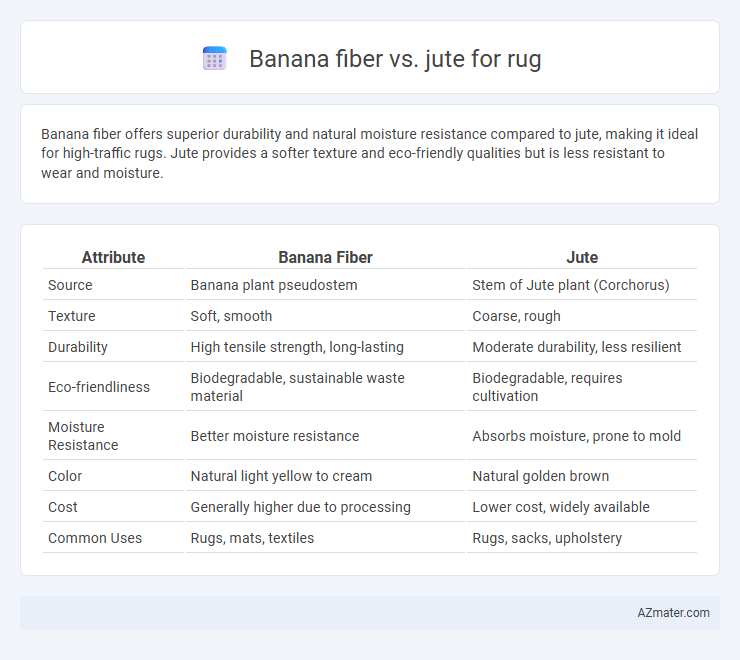Banana fiber offers superior durability and natural moisture resistance compared to jute, making it ideal for high-traffic rugs. Jute provides a softer texture and eco-friendly qualities but is less resistant to wear and moisture.
Table of Comparison
| Attribute | Banana Fiber | Jute |
|---|---|---|
| Source | Banana plant pseudostem | Stem of Jute plant (Corchorus) |
| Texture | Soft, smooth | Coarse, rough |
| Durability | High tensile strength, long-lasting | Moderate durability, less resilient |
| Eco-friendliness | Biodegradable, sustainable waste material | Biodegradable, requires cultivation |
| Moisture Resistance | Better moisture resistance | Absorbs moisture, prone to mold |
| Color | Natural light yellow to cream | Natural golden brown |
| Cost | Generally higher due to processing | Lower cost, widely available |
| Common Uses | Rugs, mats, textiles | Rugs, sacks, upholstery |
Introduction to Natural Fibers for Rugs
Banana fiber and jute are prominent natural fibers used in rug making, prized for their durability and eco-friendly qualities. Banana fiber, derived from the pseudostem of banana plants, offers a smooth texture and exceptional strength, making it ideal for high-traffic areas. Jute, sourced from the stalks of the Corchorus plant, provides a coarse, rustic appearance with excellent breathability and biodegradability, commonly used in traditional and artisanal rugs.
Overview of Banana Fiber
Banana fiber, extracted from the pseudostem of banana plants, offers a sustainable and eco-friendly alternative to traditional rug materials like jute. It boasts strong tensile strength, natural durability, and a smooth texture, making it ideal for high-traffic areas and long-lasting rugs. Compared to jute, banana fiber is more resistant to moisture and pests, enhancing the rug's longevity and overall quality.
Overview of Jute Fiber
Jute fiber, derived from the Corchorus plant, is a natural bast fiber known for its strength, durability, and eco-friendly properties, making it a popular choice for rug production. Its coarse texture and excellent breathability contribute to rugs that are both resilient and comfortable underfoot. Jute rugs offer natural moisture-wicking abilities and biodegradability, distinguishing them from synthetic alternatives and positioning them as a sustainable flooring option.
Sustainability Comparison: Banana Fiber vs Jute
Banana fiber offers higher biodegradability and requires less water and pesticides in cultivation compared to jute, making it more environmentally sustainable. Jute, while also biodegradable and renewable, has a longer growth cycle and demands more intensive agricultural inputs. Both fibers support eco-friendly rug production, but banana fiber's lower environmental footprint makes it a preferable choice for sustainability-conscious consumers.
Durability and Longevity
Banana fiber rugs are known for their high tensile strength and resistance to wear, making them exceptionally durable and long-lasting in high-traffic areas. Jute rugs, while natural and biodegradable, tend to wear down more quickly under heavy use due to their softer fibers and lower abrasion resistance. Therefore, banana fiber offers superior longevity and durability compared to jute for rugs in busy environments.
Texture and Appearance in Rugs
Banana fiber rugs offer a smooth, silky texture with a subtle sheen that enhances natural patterns, while jute rugs display a coarse, earthy texture with a matte finish, emphasizing rustic and organic aesthetics. The fine tensile strength of banana fiber allows for intricate weaving and vibrant surface details, contrasting with jute's robust, chunky fibers suitable for durable, high-traffic areas. Both fibers provide eco-friendly alternatives, but banana fiber rugs tend to have a softer hand feel, whereas jute rugs create a more rugged and tactile visual impact.
Comfort and Feel Underfoot
Banana fiber rugs offer a softer and more pliable texture compared to jute, providing enhanced comfort underfoot with a smooth, cushioned feel. Jute rugs, while durable and firm, tend to have a coarser and rougher surface that may feel less comfortable for prolonged standing or walking barefoot. The natural elasticity of banana fiber cushions impact better, making it a preferred choice for those prioritizing softness and comfort in rugs.
Maintenance and Cleaning Requirements
Banana fiber rugs require gentle cleaning with mild detergents and avoid excessive moisture to prevent fiber weakening, making maintenance moderately delicate. Jute rugs demand careful vacuuming and spot cleaning with minimal water to prevent mold and fiber deterioration, reflecting higher sensitivity to moisture. Both materials benefit from regular dusting and prompt stain treatment, but jute's natural coarseness offers slightly better durability against wear during cleaning.
Cost and Market Availability
Banana fiber rugs generally cost more than jute rugs due to the labor-intensive extraction and processing methods required, despite their durability and eco-friendliness. Jute is widely available and economically priced, making it the preferred choice in the mass market for handmade rugs. Market availability favors jute with an extensive supply chain and established demand, whereas banana fiber remains niche with limited but growing interest in sustainable textile markets.
Best Use Cases: Choosing Between Banana Fiber and Jute Rugs
Banana fiber rugs excel in high-traffic areas due to their durability and natural moisture resistance, making them ideal for kitchens and entryways. Jute rugs offer a softer texture and are best suited for low-traffic spaces like living rooms or bedrooms where aesthetic appeal and comfort are prioritized. Selecting between banana fiber and jute depends on balancing durability needs with tactile preferences, ensuring the rug suits the specific environmental and functional demands of the space.

Infographic: Banana fiber vs Jute for Rug
 azmater.com
azmater.com